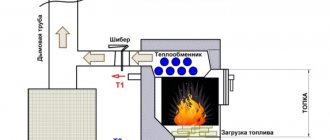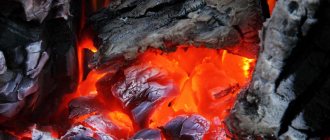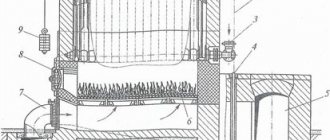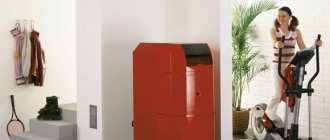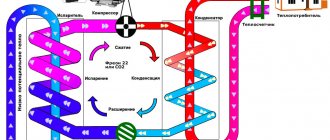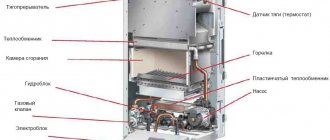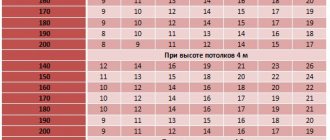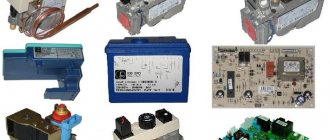To find out which coal is best to heat a solid fuel boiler in the house, you need to find the relevant information in its operating instructions. If there is no document, then it is recommended to go by trial: use different fractions and grades of coal. Then, after comparing the results, choose an acceptable option.
Coal quality indicators
This type of fuel has many characteristics, the totality of which determines its grade and brand.
But for proper operation of the boiler, it is enough to know the basics:
Caloric content (heat of combustion). This property shows the amount of energy released when a unit of fuel is burned - measured in kcal/kg. Coking coals provide the highest heat output - up to 8700. Anthracites are close to them in calorie content - up to 8600. Household solid fuel boilers are often not designed to use coking coals in them: the grate design may suffer (melt) due to high temperatures.
- Ash content. This indicator is important in determining the quality of coal. This type of fuel contains non-combustible substances: they remain in the form of ash residue after combustion. High-quality coal is characterized by a low % of the component with a greater release of heat. With an increased amount of ash, less heat is generated - such coal is considered second-class. A good component indicator is < 25% of the fuel mass; low - 40% or more. The level of ash content also affects the frequency of cleaning the boiler (or furnace) and chimney pipes.
- Humidity. With a lower percentage, more heat is generated. There are two types of humidity: surface and internal. The first is removed by drying the coal in air, and the second is removed only by combustion in a furnace. In this case, a large amount of energy is spent on side drying processes. In this situation, the quality of heating and heating deteriorates. The range of 3-15% is considered the norm for the water content in coal. The first sign of increased moisture in fuel is its freezing during the cold season or sticking together in other seasons.
Results
Heating a house with coal is a good solution, in combination with which you can also use corner heating radiators. There is no need to worry about heat loss with such a system; such devices are placed in corners, even behind the boiler.
For decades now, coal boilers have shown that they are worthy and reliable as a heating system.
Among the undeniable advantages that determine the popularity of coal-fired boilers is, undoubtedly, the fact that you can use not only coal, but also other types of fuel - hardwood, briquettes, peat, sawdust, etc. Coal-fired boilers are economical and have high heat transfer, long-lasting combustion, and the boiler itself can be used throughout the heating season without extinguishing.
Among the disadvantages of heating with coal is the need to constantly add fuel and dispose of waste. There will also be coal dust everywhere, even if you work carefully. Coal has to be prepared.
Methods for calculating the amount of coal for the winter
Most owners of private houses prefer to make preparations for the entire heating season.
In the European part of Russia it lasts from September to April. Depending on climatic conditions, different amounts of coal are consumed in different months.
Other factors affecting solid fuel consumption:
- boiler brand and design;
- type of heating;
- type of coal;
- technical characteristics of the structure, etc.
3 common methods of calculating coal consumption used by owners of private houses:
- Practical. It is used if there is no technical documentation for the boiler and it is necessary to experimentally determine the coal consumption for a conditional period. To do this, it is recommended to buy 100-150 kg (several bags) of fuel and see how much it is spent to maintain a comfortable temperature in the house in 1 day during the week. Based on the result obtained, you can calculate the consumption for a month or the entire season.
- Exemplary. It consists in knowing the average, experimentally established rate of coal consumption in the European part of Russia. For example, to heat a house with an area of 100 m² you need: in September and April 1 bucket (8 kg); December, January, February - 3-4; in March and October - 1-1.5. By multiplying the norm by the number of days in each month and summing up the results, you can get the amount of coal for the entire heating period.
- According to boiler power. It is based on a standard formula - to heat 10 m² of area you need to use 1 kW. In practice, this figure is achieved in severe frosts. At average seasonal temperatures, less fuel is consumed. For example, a house with an area of 150 m² needs a 15 kW boiler. To maintain a comfortable temperature during the day, you need to spend 15 x 24 = 360 kW of energy. 1 kg of coal gives 7.5 kW. To heat a house you need (per day) 360 / 7.5 = 48 kg. By making an adjustment for the device's rated efficiency, you can get a more accurate result.
In April and September, the estimated coal fuel consumption decreases by 50-75% from the peak winter months; in March, October by - 30-50%.
Heating engineers call the latter method of calculation conditional and capable of giving an error of up to 15-20%.
Brown coal
Brown coal is the youngest solid rock, which was formed about 50 million years ago from peat or lignite. At its core, it is “immature” coal.
This mineral got its name because of its color - shades vary from brownish-red to black. Brown coal is considered a fuel of low degree of carbonization (metamorphism). It contains 50% carbon, but also a lot of volatile substances, mineral impurities and moisture, so it burns much easier and produces more smoke and a burning smell.
Depending on the humidity, brown coal is divided into grades 1B (humidity more than 40%), 2B (30-40%) and 3B (up to 30%). The yield of volatile substances in brown coals is up to 50%.
Photo: miningwiki.ru
With prolonged contact with air, brown coal tends to lose its structure and crack. Among all types of coal, it is considered the lowest quality fuel, since it emits much less heat: the calorific value is only 4000 - 5500 kcal/kg.
Brown coal lies at shallow depths (up to 1 km), so it is much easier and cheaper to mine. However, in Russia it is used much less frequently as a fuel than coal. Due to its low cost, brown coal is still preferred by some small and private boiler houses and thermal power plants.
In Russia, the largest deposits of brown coal are located in the Kansk-Achinsk basin (Krasnoyarsk Territory). In total, the area has reserves of almost 640 billion tons (about 140 billion tons are suitable for open-pit mining).
The only coal deposit in Altai is Soltonskoye, which is rich in brown coal reserves. Its predicted reserves are 250 million tons.
About 2 trillion tons of brown coal are hidden in the Lena coal basin, located on the territory of Yakutia and the Krasnoyarsk Territory. In addition, this type of mineral often occurs together with coal - for example, it is also obtained from the deposits of the Minusinsk and Kuznetsk coal basins.
Features of fuel storage
To provide a residential building with coal for the autumn-winter-spring period, owners must provide conditions for its storage. With their proper organization, the operation of solid fuel equipment will become safe and the maximum efficiency of the unit will be achieved.
The main storage conditions:
- ease of access to fuel for transporting it to the stove;
- the presence of a special storage room near the house and maintaining comfortable conditions in it;
- good lighting and sufficient ventilation for loading and unloading operations, etc.
When the warehouse is fully loaded with fuel for the entire cold period, the main condition for its storage must be met - it must not lose its functional (combustible) properties. The main weakness of coal after mining and raising it to the surface is oxidation. The larger the pieces, the longer they will retain their properties. For example, coal with a fraction of more than 100 mm can be stored (without loss of quality) for up to 3 years, and fine coal - less than 1 year. The latter is recommended to be purchased only for 1 season.
Requirements for place and storage conditions:
- It is advisable to package the fuel in bags or wooden boxes;
- the room (except during loading and unloading) should be dark;
- if coal is poured into a special pit, it must be compacted to reduce the air gap;
- if fuel is stored in the yard, it is advisable to cover it with a lid or thick plastic wrap;
- the warehouse space must be voluminous: annual coal requirement (for 100 m² of area - 4 m³ of fuel) + passage + 5% reserve;
- the warehouse must be equipped with drainage systems for the removal of groundwater, melt water, and rainwater.
Prohibitions to the location of the storage room:
- it cannot be equipped with communications: electrical lines, gas pipelines, heating plants;
- it should not be located above underground pipelines, gas pipelines, electrical cables, etc.
Owners need to remember: if storage conditions are violated, coal can ignite.
Therefore, small pieces must be well compacted, without leaving air gaps, to avoid spontaneous combustion.
TOP 5 pellet boilers
If you still don’t know which solid fuel boiler is best to purchase for heating your home, we strongly advise you to take a closer look at pellet heating devices. Installing such a unit will allow you not to look into the boiler room at all for several days. There can be only two difficulties here:
you need to have enough places to store pellets; Such fuel material is not available in every region.
If you don’t foresee any difficulties with purchasing and storing pellets, such a boiler will definitely allow you to appear in the furnace room as little as possible.
Zota Pellet 25
One of the most popular and expensive devices is the ZotaPellet boiler. This cutting-edge unit is equipped with a liquid crystal display and is capable of controlling as many as five pumps simultaneously. Literally everything can be connected here - from underfloor heating to a centralized heating system. A power of 25 kW is quite enough for high-quality heating of a house with an area of at least 250 m2.
Pros:
- Efficiency more than 90%;
- electric ignition;
- high energy efficiency;
- reliable automation;
- high-quality thermal insulation;
- multifunctionality.
Minuses:
considerable cost, about 3300 USD. e.
Biomaster BM-15
Here is another high-quality boiler that runs on pellets. This model is good for heating a large house. Depending on the configuration, it may have a loading hopper of 200 or 400 liters. Equipped with an automatic ash removal system.
Advantages:
- absolutely not demanding on the quality of the pellets used;
- good efficiency;
- efficiency;
- ease of installation and comfort of use.
Flaws:
- cost from $2,800;
- has a lot of weight;
- requires a foundation.
Teplodar Kupper OK 30
And this unit is generally “omnivorous”. Teplodar Cooper, although it has much fewer bells and whistles, is absolutely not demanding on the quality and type of fuel. Compact dimensions allow you to comfortably place fuel equipment on an area of about 5 square meters. meters.
Pros:
- Efficiency over 89%;
- high-quality thermal insulation;
- compact dimensions;
- variety of fuels;
- automatic fuel supply;
- automatic adjustment of t˚C mode;
- ease of operation;
- low price, from $600.
Minuses:
difficult to install on your own, requires the involvement of a specialist.
Pelletron
There are only 2 modifications of boilers from this company: 40 and 20 kW, which allows you to perfectly heat rooms up to 700 or 400 m2, respectively. The cost of Pelletron pellet boilers can reach 1,500 conventional units, depending on the power.
Advantages:
- Efficiency up to 92%;
- compact dimensions;
- light weight;
- equipped with a smoke exhaust system, which allows you to do without chimney equipment;
- has automatic protection against fire or overheating.
Flaws:
- has inflated requirements for the quality and size of pellets;
- If installed and used incorrectly, fire may spread into the bunker.
Kiturami KRP 20-A
An interesting model of a pellet boiler - it can provide not only heating of the room, but also additional provision of hot water to the home.
Pros:
- auto-dosing of fuel;
- presence of a thermostat;
- possibility of heating water;
- ease and accessibility of cleaning the ash pan;
- ease of installation;
- spacious fuel bunker;
- Automatic protection against freezing or overheating.
Minuses:
price, about 3,500 US dollars.
Popular brands of solid fuel
For many centuries, people have been using various types of it for specified purposes (smelting metals, firing ceramics, etc.). But not all brands of coal are used for heating, but those suitable for their specific properties.
Table 1. Popular fuel brands and their features
| № | Name | Advantages | Flaws |
| 1 | Long flame (D) | Easy to ignite; generate quite a lot of heat; have a low cost; burn for a long time | Large emissions of furnace gas and smoke |
| 2 | Long-flame gas (LG) | ||
| 3 | Anthracite (A) | Contains a high percentage of carbon; burns almost without smoke; little ash and slag remains | Prolonged combustion; high price |
| 4 | Low Caking (SS) | In terms of quality characteristics they are inferior to other types, but have a low cost | |
| 5 | Skinny (T) | ||
Popular fractions of coal for heating a private home include:
- O (walnut) - from 25 to 50 mm;
- K (large) - from 50 to 100 mm;
- C (seeds) - from 6 to 13 mm;
- M (small) - from 13 to 25 mm.
Criterias of choice
The main one is the boiler model. If the manufacturer has technically provided for the use of 1-2 grades of coal for normal operation, then the question of choice disappears: it is necessary to use only the types of fuel specified in the operating instructions.
In other cases, heating engineers consider anthracite to be the best option. Although there are many nuances when it is more profitable to use less expensive brands. Another determining criterion for selection is the size of the fraction: fine ignites and burns faster than large ones, but more often requires a new filling.
According to this criterion, preference is given to “nuts” (50 mm) and large ones (up to 80 mm). Such coal will burn longer and produce more heat.
How to properly heat a solid fuel boiler
The process of operating the device consists of the following stages:
- Pre-ignition. On the grate you need to make a small fire from paper and wood chips. You can use other materials: branches, birch bark, sawdust. Place large logs on top and set fire. To ensure air circulation, do not place the components of the fire too tightly together.
- Primary bookmark. It is made on the coals of a fire, in a small portion, about 1-2 handfuls from both hands. The smaller the fuel fraction, the faster the combustion will occur. Then you need to periodically stir the pieces of coal for high-quality ignition.
- When the first batch of fuel flares up, you can add the next one. Now you can take larger pieces.
Next, you need to monitor the boiler and add fuel as necessary. According to the instructions, it is clear that in addition to coal, other materials are involved in the process of igniting the unit. Therefore, owners need to stock up on firewood and wood chips based on seasonal needs. It is better to store them under a canopy or in another room to keep them dry.
More fuel - more danger?!
Coal fuel is a help. But many are concerned: along with benefits for the consumer, it also carries great dangers for those who extract it. Driving even more people into the mines, where everything falls apart, is not an option. Previously, in a safer way, only deposits at a depth of no more than 100 meters were taken by quarrying. In other cases, it was impossible to do without mines and heavy manual work.
Nowadays, they are increasingly turning to the hydraulic method of rock excavation. Safety for workers is reduced. The excavation speed (due to pumps and hydraulic monitors) increases.
Mechanical-hydraulic rock excavation is also popular. Special combines and pressure equipment are used. Minerals in this case are actually simply washed away and then transported upward (also using hydraulic engineering).
Why are such methods not used everywhere? The answer is simple - it’s not cheap, although over time it will more than pay for itself. After all, coal fuel is being used more and more often. The main thing is to choose a high-quality and convenient boiler.
One of the well-known series of boilers for which coal chips and briquettes can be used is the TIS HARD EKO series. The equipment included in it can be used for heating homes, schools, and factories. The series even includes such powerful models that can handle areas over 5000 m2.
Burning of crumbs or briquettes is carried out automatically. The process involves a screw, a fan and a burner.
Combustion control is carried out using a special microprocessor unit. Since it has a self-cleaning function, the equipment is very easy to maintain.
Please note: the manufacturer made sure that the bunker was filled to 2/3 of its volume. Due to this, grinding of coal into dust in the lower sections is minimized.
What to do if the fuel burns poorly
On Internet forums, people who use a stove or boiler to heat a room raise this issue. The answers of heating engineers can be combined into 4 groups based on several characteristic signs of poor-quality equipment operation.
Table 2. Solutions to the problem of poor combustion quality
| № | The reason for the deterioration of combustion | Elimination method |
| 1 | Clogged chimney and ducts | Thorough cleaning of the entire structure |
| 2 | Using old coal. It is noted that already in the second year of storage the fuel burns worse | Purchase of fresh coal (current year of production) |
| 3 | Wear of the furnace device, burnout of the grate | Repair and replacement of worn components |
| 4 | Increased moisture content of coal | Air drying in dry and windy weather |
Coal heating pros and cons
Coal-fired heating systems cope well with increased heating demands in severe frosts. One of its main advantages is its ability to retain heat for a long time. In addition, coal stove heating has other advantages:
- independence from the availability of main energy resources (electricity, gas);
- availability: coal, like the boilers themselves, is domestic and inexpensive;
- efficiency: average efficiency for different types of equipment - 70%;
- autonomy: if you purchase the appropriate model, you will not depend on electricity and gas;
- simplicity of design ensures long-term uninterrupted operation of the device;
- automation: many models themselves solve issues of fuel supply and thermoregulation.
Despite the improvement of technology, coal devices are not without drawbacks:
- In order for combustion to bring maximum efficiency, special conditions will have to be observed: requirements for the brand, quality, and humidity of the burned raw materials.
- The need to allocate a utility room for storing fuel and installing the unit.
- The cyclical nature of the process means different loading frequencies (depending on the type of device). Coal will have to be loaded into any boiler.
- Maintenance required: removal of soot, soot, ash, cleaning.
Many devices require the installation of auxiliary devices such as pumps and forced ventilation units. Despite the automation of many systems, coal generators require constant monitoring.
